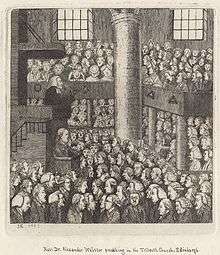Alexander Webster

Alexander Webster (1708 – January 25, 1784) was a Scottish writer and minister, son of James Webster, a covenanting minister originally from Fife, was born in Edinburgh.
Alexander became a minister of the Church of Scotland, beginning his career in Culross in Fife. There he met and married Mary Erskine of Alva, for whom he wrote:
- When I see thee, I love thee, but hearing adore,
- I wonder, and think you a woman no more;
- Till, mad with admiring, I cannot contain,
- And, kissing those lips, find you woman again.
They had several children. Mary, whose sister Euphemia was the mother of James Boswell, died of fever in 1766.
He propounded a scheme in 1742 for providing pensions for the widows of ministers. The tables which he drew up from information obtained from all the presbyteries of Scotland were based on a system of actuarial calculation that supplied a precedent followed by insurance companies in modern times for reckoning averages of longevity.[1]
Webster published in 1748 his Calculations, setting forth the principles on which his scheme for widows' pensions was based; he also wrote a defence of the Methodist movement in 1742, and Zeal for the Civil and Religious Interests of Mankind Commended (1754).[1]
In 1755 the government commissioned Webster to obtain data for the first census of Scotland, which he carried out in the same year. In 1753 he was elected moderator of the General Assembly; in 1771 he was appointed a dean of the Chapel Royal and chaplain to George III in Scotland.[1]
Socially, despite his 'High Flying' Evangelical position in the Kirk, he was a convivial man, known as Bonum Magnum for his capacity for claret. His wife's nephew Boswell often mentions dining with the family.
His two eldest sons, John (b. 1738) and James (b. 1740), served in the American Revolutionary War. John was a Captain in the 4th Regiment of Foot. James ('Jamie') was especially well regarded as Lieutenant-Colonel of the 33rd Foot, Lord Cornwallis's own regiment, and acting Brigadier. When he died of wounds after the battle of Guilford Courthouse in 1781, Cornwallis wrote a touching letter of condolence to Alexander Webster.
He is buried beside Mary in Greyfriars Kirkyard, Edinburgh, in a now-unmarked grave.
Notes
- 1 2 3
 One or more of the preceding sentences incorporates text from a publication now in the public domain: Chisholm, Hugh, ed. (1911). "Webster, Alexander". Encyclopædia Britannica. 28 (11th ed.). Cambridge University Press. p. 459.
One or more of the preceding sentences incorporates text from a publication now in the public domain: Chisholm, Hugh, ed. (1911). "Webster, Alexander". Encyclopædia Britannica. 28 (11th ed.). Cambridge University Press. p. 459.
References
- Robert Chambers, Traditions of Edinburgh, 1824.